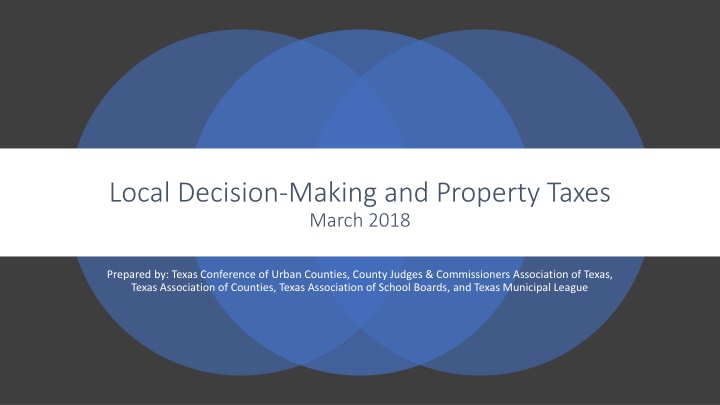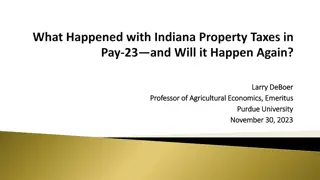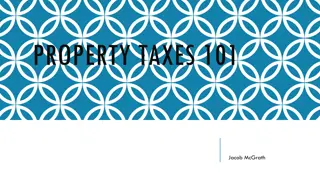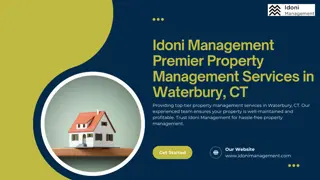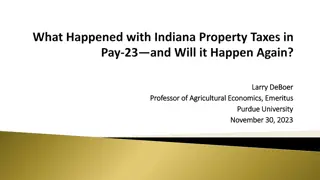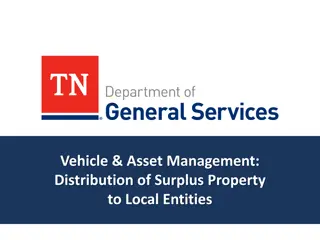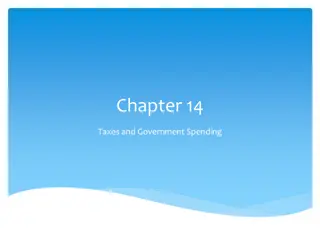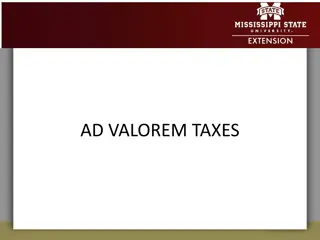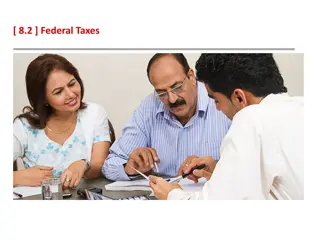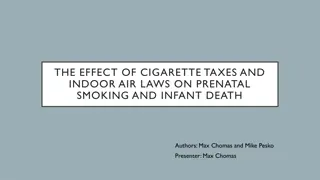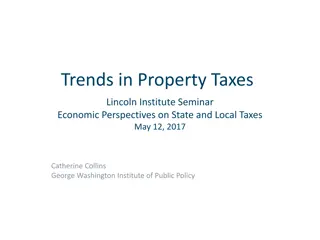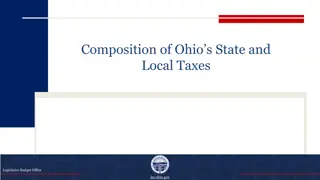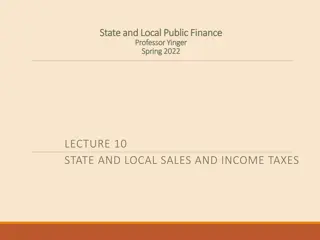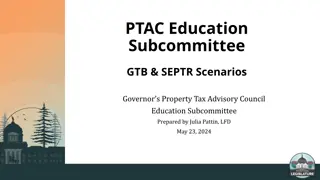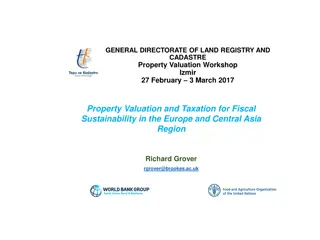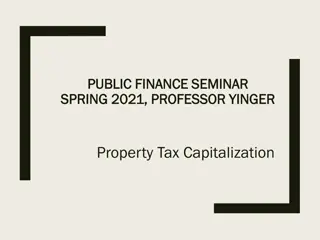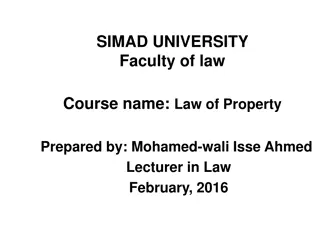Property Taxes and Local Decision-Making in Texas
Texas relies on property taxes and sales taxes as major revenue sources for state and local government funding. The majority of property taxes fund public schools, with the burden increasing due to unfunded mandates from the Texas Legislature. Student funding is impacted by property value growth, benefiting the state's general revenue fund over school districts.
Download Presentation

Please find below an Image/Link to download the presentation.
The content on the website is provided AS IS for your information and personal use only. It may not be sold, licensed, or shared on other websites without obtaining consent from the author.If you encounter any issues during the download, it is possible that the publisher has removed the file from their server.
You are allowed to download the files provided on this website for personal or commercial use, subject to the condition that they are used lawfully. All files are the property of their respective owners.
The content on the website is provided AS IS for your information and personal use only. It may not be sold, licensed, or shared on other websites without obtaining consent from the author.
E N D
Presentation Transcript
Local Decision-Making and Property Taxes March 2018 Prepared by: Texas Conference of Urban Counties, County Judges & Commissioners Association of Texas, Texas Association of Counties, Texas Association of School Boards, and Texas Municipal League
Texas relies on property taxes and sales taxes to fund state and local government. Property Tax (14th) Sales Tax (10th) Income Tax (N/A) State
The Majority of Property Taxes Fund Public Schools Special District Growth of the Property Tax by Taxing Unit Type 30 13% 25 County 20 School District DOLLARS (IN BILLIONS) 15 17% 10 54% City 5 16% - 2008 2009 2010 2011 2012 2013 2014 2015 Special Purpose District Levy 4,952,734,9 5,133,820,4 5,392,511,5 4,926,074,0 5,543,422,3 5,529,434,2 6,370,469,8 6,954,137,4 County Levy 6,342,704,9 6,526,724,0 6,567,069,8 6,742,912,7 7,064,659,1 7,537,749,4 8,114,998,1 8,696,387,3 City Levy 6,451,012,4 6,593,755,0 6,755,401,4 6,810,049,3 7,054,989,7 7,324,430,8 7,828,571,7 8,380,435,8 School Levy 21,233,517, 21,780,056, 21,558,289, 22,001,561, 23,072,781, 24,854,671, 26,792,677, 28,176,465, Source: Texas Comptroller of Public Accounts, 2015 property Tax Levies 3
The Texas Legislature s method of funding schools and its passage of unfunded mandates increases the property tax burden on local taxpayers. Public schools are funded through: State General Revenue Fund Local Property Taxes Federal Funds 4
Student Funding Higher school taxes because of property value growth benefit the State s general revenue fund, not school districts. Local Aid per Student State Aid per Student Federal Aid per Student 60% 50% 40% PERCENTAGE SPLIT School districts are held to a certain amount of funding per pupil. When property tax revenue increases due to rising property values, the State does not increase per-pupil funding. Instead, the State lowers its percentage of total school funding. 30% 20% 10% 0% 2008 2009 2010 2011 2012 2013 2014 2015 2016 2017 45% 43% 46% 44% 46% Local Aid per Student State Aid per Student 48% 49% 50% 49% 52% 45% 44% 38% 40% 43% 41% 41% 39% 41% 38% Federal Aid per Student 10% 14% 16% 16% 11% 11% 10% 10% 10% 10% FISCAL YEAR 5
Foundation School Program: The State Share is Falling History 1985-2016 (2017-2019 estimated by LBB) 35 30 25 Billions of Dollars 20 15 10 5 0 Fiscal Year State FSP Spending Local FSP Spending *Data for FY17-FY19 are estimated Source: Direct from LBB, General Appropriations Act, Texas Education Agency 6
Had the State increased its share to be a 50/50 partner in funding schools for 2016 2019, local school property taxes could have been reduced by more than $17 billion an average of 15% each year. Since 2015, the Texas Legislature increased school funding from local property taxes $14.35 Billion while state funding increased $2.17 Billion Source: Legislative Budget Board 7
If the State of Texas doesnt assume its share, the problem will only get worse. Student Projected Student Enrollment (2019): Enrollment (2015): 4,852,600 5,166,298 Source: General Appropriations Act FY 18 FY 19 8
General Appropriations Act FY18-19 The legislature reduced the State s share of public education funding. The budget that the legislature passed counts on over 14% increase in local property taxes over the FY 18- 19 tax years. 9
Surging property taxes are directly linked to the state s school finance system. More State Investment in Public Education Will Lower Property Taxes The state s dependence on local property taxes is enormous and clear, while school districts costs continue to increase with 60% of students who are economically disadvantaged, and 20% that are English Language Learners. Two ways of reducing local property taxes: 1. Increase state investment; and 2. Pass legislation so that school districts are not penalized for lowering tax rates. 11
Local governments, and property taxpayers by extension, face billions of dollars of unfunded and underfunded mandates from both the federal and state governments. Unfunded Mandate An unfunded mandate is a state law or regulation that requires a local government to perform certain actions, with no money provided by the state to fulfill the requirements. 12
To shore up the lack of state funding for highways, cities and counties must pay hundreds of millions of dollars each year to TxDOT as local participation on state highway projects. Unfunded Mandate: Reverse Intergovernmental Aid To fund more than 50% of the state Comptroller s office, cities pay a hefty 2% fee for administration of local sales tax. 13
Each year, county and city court staff collect and transfer to the state hundreds of millions in state fees. Those fees are not used by the state to fund the state justice system. Unfunded Mandates Further, the state demands all of its fees before counties and cities can keep any fines. 14
County officials rely almost exclusively on property tax revenue to efficiently fund the state s criminal justice system, critical community health initiatives, and other statewide programs that are passed down to local counties by state officials. Unfunded Mandates 15
Unfunded Mandate Indigent Defense Texas Indigent Defense Expenditures by Fiscal Year in Millions of Dollars Source: Texas Indigent Defense Commission $300 $250 $216 $208 $185 Millions of Dollars $200 $190 $179 $165 $167 $159 $153 $150 $144 $135 $126 $127 $118 $100 $107 $91 $50 $0 $7 $12 $12 $14 $14 $18 $22 $28 $28 $34 $28 $27 $45 $30 $32 $0 2001 2002 2003 2004 2005 2006 2007 2008 Fiscal Year 2009 2010 2011 2012 2013 2014 2015 2016 State Reimbursements County Unreimbursed Expenditures 16
Unfunded Mandate: State Inmates in County Jails Convicts ready to be sent to state prison can be left in county jails for up to 45 days without reimbursement by the state In 2017, this increased local property taxes by more than $58.6 million County jails are required to hold state parolees awaiting hearings for technical violations more than 2100 on an average day In 2017, this increased local property taxes by more than $47.5 million 17
The Texas Legislature since 1984 has not updated the transportation allotment, a major contributing cost factor to a school district s local taxpayers. Unfunded Mandates A recently approved law for teacher retirement requires both teachers and school districts to contribute a higher percentage into the Teacher Retirement System than the percent contributed by the state. Mandatory state assessments costs taxpayers millions as teachers workloads are increased and additional staff are hired to administer exams. 18
Cities, counties, and school boards know the values of their community and are the governments closest to the people. The state created cities, counties, and school boards to permit citizens to make local decisions. The locally elected leaders of cities, counties, and school boards decide how to provide appropriate services for the people who live in their communities. Local Governments in Texas Lead the Way 20
What Do Local Governments Do? COMMUNITY OVERSIGHT We provide essential services Births, Deaths, Marriages, Divorces, Deeds, Housing, Economic Development, Land Use Planning, Tax Assessment & Collection ELECTIONS We ensure your voice is heard Voter Registration Local, State, National Elections TRANSPORTATION We connect communities Roads, Bridges, and Highways EMERGENCY MANAGEMENT We are the first responders Prepare, Prevent, Plan, Respond and Recover PUBLIC SCHOOLS We educate the future 5.4 million students adding an additional 80,000 a year INFRASTRUCTURE We support community growth Utilities, Ports, Airports, Parks, and Libraries HEALTH We work to strengthen and protect families Public Health, Solid Waste, Medical Examiner, Immunizations, Veterans Services, and Social Services PUBLIC SAFETY We keep communities secure Fire Protection, EMS Law Enforcement, Jails and Justice of the Peace COURTS We oversee justice Courts, District Attorneys, Public Defenders, Indigent Defense, Probation, Court Clerks, Juvenile Services
Preserving local decision- making equips Texans and their local government officials with the ability to address the unique challenges of their communities. Preserve Local Decision-Making Local governments have been the state s partner on the ground, doing the work locally to enact the will of the state, efficiently and effectively in the ways that best fit their local communities. 22
The local government revenue controls supported by some state officials threaten to undermine community priorities. Politicians from one part of the state should not dictate priorities for communities in other parts of the state. Arbitrarily imposing a revenue cap circumvents the democratically-elected local governments that are in the best position to determine the right policy decisions for each community. One Size Does Not Fit All Arbitrary revenue caps don t take into account local priorities and the unexpected services demands local governments can experience from things like significant population growth and, of course, disasters. 23
The State should be a 50/50 partner in funding the operation and maintenance of our schools. The Texas Legislature should pass a constitutional amendment to stop unfunded mandates. Solutions The State should reimburse counties for holding state inmates in county jails, and should fully fund indigent defense costs. Leave local decisions to local communities and their elected officials. 24
